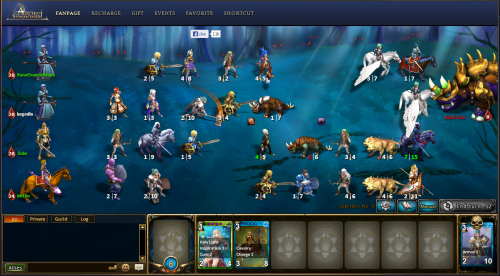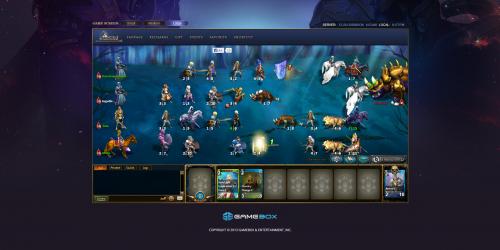I talk the talk, but I do not walk the walk. Ancient Summoner is everything I’m supposed to dislike about modern gaming. It’s predatory in its methods and it serves to steal your time and leach money out of you, instead of giving you actual, proper enjoyment. And yet, I’ve been playing it for hours over the past week.
What is Ancient Summoner?
Ancient Summoner is a web game, or a browser game, to use the more common term. In addition, it’s a trading card / RPG.
You start out with a lengthy tutorial which lasts for well over an hour, or at least it seemed that way. Through this tutorial, you learn the ropes, which aren’t really all that complicated, and you advance several levels before the game’s guide leaves you to do your own thing.
There are several aspects to Ancient Summoner, but none of them are really that complex.
Trading Cards
The cards also split into creature and skill cards.
The creature cards are divided into races. There are Humans, Elves, Undead, Beast and Halfblood. You can get more cards with quests, by buying booster packs, which come in several categories, by combining them, or by trading them on the auction house. The races do have a certain gameplay style to them, but overall, there isn’t much difference, other than the look.
The skill cards are divided into classes. You have your own character within the game and you pick a class for them at the start, though you can also change it later with a special item. You can only use skill cards of your own class, which is Mage, Priest, Ranger of Warrior, so changing the class can be a very desirable thing later on, depending on which skill cards drop for you.
Each creature card also has a rank, which affects its stats, so you can have a Common Rank Elven Archer, or a Good Rank Elven Archer and it makes quite a difference.
Resources and the Paywall
There’s a whole bunch of resources within the game, each serving a different role. You get some of them through quests, some through crafting, and some through PVP or in basically any other way. This is where the Cash Shop comes in.
You buy gold with the cash shop. Gold can also drop in other ways and you get fixed amounts when you reach certain milestones, but it’s rare. The equivalent to gold is silver, which you get a lot of within the game. Most things that you buy with silver, you can buy much faster and more easily with gold. Additionally, gold can be used to complete quests instantly, get more other resources or even buy cards directly on the auction house. In fact, if you want to put items on the auction house, you first need gold.
Overall, it’s quite a big paywall and if you’re willing to spend money, you get a big advantage in Ancient Summoner, but the game is somehow still addictive (I won’t say “fun”) without spending a cent.
The thing is, sometimes you really wish you’d just have a bit more gold, since a lot of these things are time dependent otherwise, like your average Facebook game would be.
RPG Elements or why Ancient Summoner is a Skinner box
It is a Skinner box. It’s not a bad term. In fact, Skinner box is a pretty good term to describe most if not all current MMO games. After all, the goal of an MMO is to somehow convince you to keep playing. Sure, making the game fun and entertaining would be the preferable way to do so, but that’s difficult. It takes a lot of work and resources to make the game fun and also keep it fun for as long as possible.
A skinner box is a less resource intensive method to do it and it works almost just as well, if not better than the preferable approach. Basically, the game gives you small “rewards” on a regular basis for minor, mundane and completely unimpressive achievements. This gives you a sense of progression and provides the added effect of tying you to the game and creating a sense of attachment to it.
I have to admit, it works almost too perfectly with Ancient Summoner and myself. First of all, you have your character which gains levels. With more levels, you get more buildings to build in your town and more gameplay options. You deck size also increases with levels.
Secondly, there’s a load of quests within Ancient Summoner. Most of them are relatively easy to complete, but they also provide you with minor, but measurable rewards. There are also daily quests and special event quests which repeat periodically, so you have a reason to log in every day.
Thirdly, your headquarters allow you to collect taxes, which you also do on a daily basis, so there’s another reason to log in.
Fourthly (there’s a lot of these ly’s), you collect cards, since it’s a trading card game. There’s a bunch of ways to do this and there’s a lot of cards to collect. Not all cards are equal so having a better deck is one motivator to collect them. If that isn’t enough, there’s also a nice tracker for how many cards of each category you have, and you get rewards if you reach milestones within those categories.
Fifthly, your character has equipment. You get it from quests, random drops after winning fights or special events, or through some other means.
Sixthly, we have crafting. Two of the buildings in your town are the blacksmith and the alchemist. At the blacksmith’s, you can enchant your equipment by using special items. Increasing the level of your blacksmith building increases the chance of success. Once you increase the building to level 5, you can also start combining low level items into a higher level item, so your equipment basically also levels all on its own. The other building, the alchemist, allows you to fuse low level cards into higher level cards, extract resources from cards and combine those resources into other cards.
Seventhly, there’s reputation. You get reputation in each of the card categories, be it a race or a class. Once you reach some reputation levels, you also gain rewards and new gameplay options, such as buying some cards outright. You can also increase reputation by replaying certain levels in the campaign map you already went through.
Eighthly, there are booster packs. You can buy booster packs for silver, gold or a third form of currency the name of which escapes me. All booster packs give the same amount of cards, but more expensive booster packs have a higher chance of granting higher rank cards.
Ninthly, there are the various activity rewards. You get rewards for logging in daily, reaching milestones, or simply remaining online for a certain amount of time. Even if you go offline, you can use your shipyard to go on an expedition while offline, which gathers resources based on the type of expedition. The longest an expedition can take is twelve hours, so this gives you another reason to log in daily and often.
So yeah, Ancient Summoner is a Skinner box
… and it isn’t an especially amazing Skinner box at that.
Then again, the card battles can be challenging and there’s plenty of strategy involved. The rest of the game can be played on auto-pilot, more or less, so it doesn’t drain a huge amount of time, since I mostly play it while browsing reddit or something like that.
I’m sure I’ll eventually get sick of the game and wonder why the hell I wasted my time on it, but for now, I’m hooked and I’ll probably stay that way for a few days longer. There’s even a potential completion goal I could set for myself – play through the entire campaign. The thing is, there won’t be much to write about the game, since there’s no real depth to it.
I’ll try to make it one or two more articles, but I’ll have to be extremely creative to manage it.
For now, if you want to join in, you can find me on S3 – Bloodmoon as begedin. Feel free to add me, just make sure you send me a PM first, since I usually refuse friend requests (they’re extremely spamy in this game).











